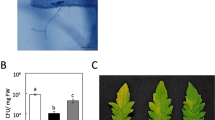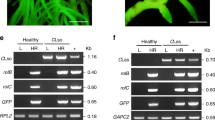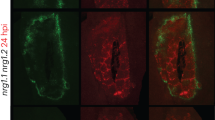Abstract
Most plant species are resistant to most potential pathogens. It is not known why most plant–microbe interactions do not lead to disease, although recent work indicates that this basic disease resistance is multi-factorial1,2. Here we show that the exudation of root-derived antimicrobial metabolites by Arabidopsis thaliana confers tissue-specific resistance to a wide range of bacterial pathogens. However, a Pseudomonas syringae strain that is both at least partly resistant to these compounds and capable of blocking their synthesis/exudation is able to infect the roots and cause disease. We also show that the ability of this P. syringae strain to block antimicrobial exudation is dependent on the type III secretory system.
This is a preview of subscription content, access via your institution
Access options
Subscribe to this journal
Receive 51 print issues and online access
$199.00 per year
only $3.90 per issue
Buy this article
- Purchase on Springer Link
- Instant access to full article PDF
Prices may be subject to local taxes which are calculated during checkout



Similar content being viewed by others
References
Nishimura, M. & Somerville, S. Plant biology. Resisting attack. Science 295, 2032–2033 (2002)
Thordal-Christensen, H. Fresh insights into processes of nonhost resistance. Curr. Opin. Plant Biol. 6, 351–357 (2003)
Bais, H. P., Fall, R. & Vivanco, J. M. Biocontrol of Bacillus subtilis against infection of Arabidopsis roots by Pseudomonas syringae is facilitated by biofilm formation and surfactin production. Plant Physiol. 134, 307–319 (2004)
Yu, G. L., Katagiri, F. & Ausubel, F. M. Arabidopsis mutations at the RPS2 locus result in loss of resistance to Pseudomonas syringae strains expressing the avirulence gene avrRpt2. Mol. Plant Microbe Interact. 6, 434–443 (1993)
Davis, K. R., Schott, E. & Ausubel, F. M. Virulence of selected phytopathogenic pseudomonads in Arabidopsis thaliana. Mol. Plant Microbe Interact. 4, 477–488 (1991)
Dong, X., Mindrinos, M., Davis, K. R. & Ausubel, F. M. Induction of Arabidopsis defense genes by virulent and avirulent Pseudomonas syringae strains and by a cloned avirulence gene. Plant Cell 3, 61–72 (1991)
Debener, T., Lehnackers, H., Arnold, M. & Dangl, J. L. Identification and molecular mapping of a single Arabidopsis thaliana locus determining resistance to a phytopathogenic Pseudomonas syringae isolate. Plant J. 1, 289–302 (1991)
Walker, T. S., Bais, H. P., Grotewold, E. & Vivanco, J. M. Root exudation and rhizosphere biology. Plant Physiol. 132, 44–51 (2003)
Walker, T. S., Bais, H. P., Halligan, K. M., Stermitz, F. R. & Vivanco, J. M. Metabolic profiling of root exudates of Arabidopsis thaliana. J. Agric. Food Chem. 51, 2548–2554 (2003)
Callaway, R. M. & Aschehoug, E. T. Invasive plants versus their new and old neighbors: a mechanism for exotic invasion. Science 290, 521–523 (2000)
Bais, H. P., Vepachedu, R., Gilroy, S., Callaway, R. M. & Vivanco, J. M. Allelopathy and exotic plant invasion: from molecules and genes to species interactions. Science 301, 1377–1380 (2003)
Nikaido, H. Multiple antibiotic resistance and efflux. Curr. Opin. Microbiol. 1, 516–523 (1998)
Galan, J. E. & Collmer, A. Type III secretion machines: bacterial devices for protein delivery into host cells. Science 284, 1322–1328 (1999)
Roine, E. et al. Hrp pilus: an hrp-dependent bacterial surface appendage produced by Pseudomonas syringae pv. tomato DC3000. Proc. Natl Acad. Sci. USA 94, 3459–3464 (1997)
Xiao, Y., Heu, S., Yi, J., Lu, Y. & Hutcheson, S. W. Identification of a putative alternate sigma factor and characterization of a multicomponent regulatory cascade controlling the expression of Pseudomonas syringae pv. syringae Pss61 hrp and hrmA genes. J. Bacteriol. 176, 1025–1036 (1994)
Zwiesler-Vollick, J. et al. Identification of novel hrp-regulated genes through functional genomic analysis of the Pseudomonas syringae pv. tomato DC3000 genome. Mol. Microbiol. 45, 1207–1218 (2002)
Bender, C. L., Alarcon-Chaidez, F. & Gross, D. C. Pseudomonas syringae phytotoxins: mode of action, regulation, and biosynthesis by peptide and polyketide synthetases. Microbiol. Mol. Biol. Rev. 63, 266–292 (1999)
Dixon, R. A. Natural products and plant disease resistance. Nature 411, 843–847 (2001)
Papadopoulou, K., Melton, R. E., Leggett, M., Daniels, M. J. & Osbourn, A. E. Compromised disease resistance in saponin-deficient plants. Proc. Natl Acad. Sci. USA 96, 12923–12928 (1999)
Haralampidis, K. et al. A new class of oxidosqualene cyclases directs synthesis of antimicrobial phytoprotectants in monocots. Proc. Natl Acad. Sci. USA 98, 13431–13436 (2001)
Reimmann, C. & VanEtten, H. D. Cloning and characterization of the PDA6–1 gene encoding a fungal cytochrome P-450 which detoxifies the phytoalexin pisatin from garden pea. Gene 146, 221–226 (1994)
Bouarab, K., Melton, R., Peart, J., Baulcombe, D. & Osbourn, A. A saponin-detoxifying enzyme mediates suppression of plant defences. Nature 418, 889–892 (2002)
Sesma, A. & Osbourn, A. E. The rice leaf blast pathogen undergoes developmental processes typical of root-infecting fungi. Nature 431, 582–586 (2004)
Murashige, T. & Skoog, F. A revised medium for rapid growth and bioassays with tobacco tissue cultures. Physiol. Plant. 15, 473–497 (1962)
Whalen, M. C., Innes, R. W., Bent, A. F. & Staskawicz, B. J. Identification of Pseudomonas syringae pathogens of Arabidopsis and a bacterial locus determining avirulence on both Arabidopsis and soybean. Plant Cell 3, 49–59 (1991)
Lindgren, P. B., Peet, R. C. & Panopoulos, N. J. Gene cluster of Pseudomonas syringae pv. ‘phaseolicola’ controls pathogenicity of bean plants and hypersensitivity of nonhost plants. J. Bacteriol. 168, 512–522 (1986)
Fillingham, A. J. et al. Avirulence genes from Pseudomonas syringae pathovars phaseolicola and pisi confer specificity towards both host and non-host species. Physiol. Mol. Plant Pathol. 40, 1–15 (1992)
Rich, J. J., Hirano, S. S. & Willis, D. K. Pathovar-specific requirement for the Pseudomonas syringae lemA gene in disease lesion formation. Appl. Environ. Microbiol. 58, 1440–1446 (1992)
Brooks, D. M. et al. Identification and characterization of a well-defined series of coronatine biosynthetic mutants of Pseudomonas syringae pv. tomato DC3000. Mol. Plant Microbe Interact. 17, 162–174 (2004)
National Committee for Clinical Laboratory Standards (NCCLS). Methods for Dilution Antimicrobial Susceptibility Tests for Bacteria that Grow Aerobically. Approved Standard M7–A6 5th edn (NCCLS, Wayne, Pennsylvania, USA, 2003)
Acknowledgements
We thank W. Songnuan and J. Dangl for critical reading of the manuscript, and E. Wortman-Wunder for editing suggestions. This work was supported by the Colorado State University Agricultural Experiment Station (J.M.V.) and by NIH and NSF grants to F.M.A. J.M.V. is a NSF-CAREER Faculty Fellow.
Author information
Authors and Affiliations
Corresponding authors
Ethics declarations
Competing interests
The authors declare that they have no competing financial interests.
Supplementary information
Supplementary Methods
This file contains additional details of methods and materials used in the study. (DOC 86 kb)
Supplementary Figures S1-S8
This file contains Supplementary Figures S1-S8 (PPT 34891 kb)
Supplementary Legends
Legends to accompany the above Supplementary Figures. (DOC 53 kb)
Supplementary Table S1
Ten secondary metabolites detected in the root exudates of A. thaliana depicted as marker compounds. (PPT 170 kb)
Rights and permissions
About this article
Cite this article
Bais, H., Prithiviraj, B., Jha, A. et al. Mediation of pathogen resistance by exudation of antimicrobials from roots. Nature 434, 217–221 (2005). https://doi.org/10.1038/nature03356
Received:
Accepted:
Issue Date:
DOI: https://doi.org/10.1038/nature03356
This article is cited by
-
Tapping the rhizosphere metabolites for the prebiotic control of soil-borne bacterial wilt disease
Nature Communications (2023)
-
Physicochemical properties of oil in water emulsions prepared with irradiated gum tragacanth in acidic conditions
Journal of Food Measurement and Characterization (2021)
-
Vanillic acid changed cucumber (Cucumis sativus L.) seedling rhizosphere total bacterial, Pseudomonas and Bacillus spp. communities
Scientific Reports (2018)
-
Variety specific relationships between effects of rhizobacteria on root exudation, growth and nutrient uptake of soybean
Plant and Soil (2017)
-
An endophytic Streptomyces sp. strain DHV3-2 from diseased root as a potential biocontrol agent against Verticillium dahliae and growth elicitor in tomato (Solanum lycopersicum)
Antonie van Leeuwenhoek (2016)
Comments
By submitting a comment you agree to abide by our Terms and Community Guidelines. If you find something abusive or that does not comply with our terms or guidelines please flag it as inappropriate.



